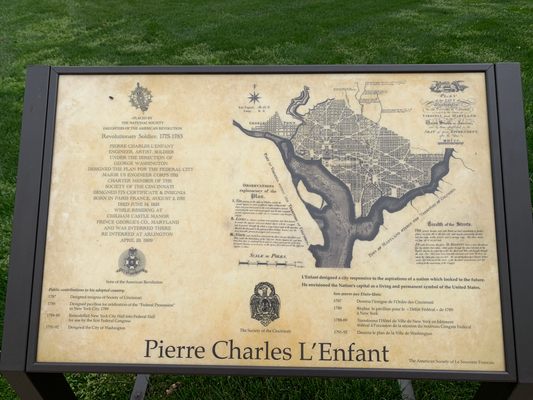About
Pierre L’Enfant was a brilliant but abrasive Frenchman who conceived Washington, D.C.’s urban layout, ran amok of all who attempted to control his excesses, and ended up dying penniless in a self-imposed exile. His life's work is now memorialized in Arlington National Cemetery, overlooking the innovative city grid born of his imagination.
Development in the area was sparse when a 100-square-mile District of Columbia was carved out of Maryland and Virginia in 1790. George Washington appointed Continental Army Major L’Enfant to travel down to the swamp and report back with a city plan that laid out the streets and delineated the property lots.
L’Enfant jumped at the prestigious project and was soon to be found riding around the territory with his surveying tools and measuring instruments. The city plan was a consequential document and the major received plenty of unsolicited advice from leading thinkers.
Thomas Jefferson was just one who thought that Philadelphia offered a fine model, with an orderly grid that fit in nicely with Enlightenment principles. L’Enfant favored a more creative matrix of broad diagonal avenues with plentiful traffic circles and interurban green spaces. This ahead-of-its-time concept predated similar urban planning like Baron Haussmann’s much-lauded “renovation of Paris” by half a century.
L’Enfant’s ideas were good but his manner of execution invited frequent conflict. L’Enfant seemed to actively seek out fights with his managers despite frequent reminders that his position was subordinate to the three-man D.C. Board of Commissioners. In one absurd and illuminating instance, the planner tore down a home belonging to one of the commissioners that encroached a few feet into one of his intended streets. The house was practically in the middle of nowhere at the time, and the street was just hypothetical. The demolition was not well received with the powers that be.
L’Enfant only lasted a year on the job. And while his engraved map went on to shape two centuries of urban development in Washington, the city planner never received compensation from the annoyed federal government. After bungling the management of subsequent projects, L’Enfant found his reputation tarnished and struggled financially for the rest of his life. He passed away in 1825 with just $42 in assets and was buried in an unmarked grave on Digges Farm in Prince Georges County, Maryland.
Tempers cooled and appreciation for L’Enfant’s achievements grew in the decades after his death. The D.C. Board of Commissioners eventually ordered L’Enfant’s corpse disinterred, and rededicated a memorial gravesite in Arlington National Cemetery in 1911 overlooking his beloved city. Though an ever penny-minded Congress approved only $1,000 for the project (an earlier appropriation bill had asked for $50,000). The final design features a stone tabletop engraved with a portion of L'Enfant's map.
Reverend William Russell gave a fitting tribute with the observation that the planner “needs no monument of marble or of bronze. The city beautiful at his feet is the proudest and most enduring monument we can erect to his memory.”
Related Tags
Know Before You Go
L’Enfant’s grave is ironically located in a part of Washington that was retroceded to the State of Virginia in 1846, in a move he likely would have likely found unthinkable.
Community Contributors
Added By
Published
September 26, 2017








































